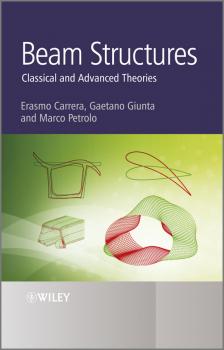ТОП просматриваемых книг сайта:
Erasmo Carrera
Список книг автора Erasmo CarreraАннотация
The finite element method (FEM) is a computational tool widely used to design and analyse complex structures. Currently, there are a number of different approaches to analysis using the FEM that vary according to the type of structure being analysed: beams and plates may use 1D or 2D approaches, shells and solids 2D or 3D approaches, and methods that work for one structure are typically not optimized to work for another. Finite Element Analysis of Structures Through Unified Formulation deals with the FEM used for the analysis of the mechanics of structures in the case of linear elasticity. The novelty of this book is that the finite elements (FEs) are formulated on the basis of a class of theories of structures known as the Carrera Unified Formulation (CUF). It formulates 1D, 2D and 3D FEs on the basis of the same 'fundamental nucleus' that comes from geometrical relations and Hooke's law, and presents both 1D and 2D refined FEs that only have displacement variables as in 3D elements. It also covers 1D and 2D FEs that make use of 'real' physical surfaces rather than ’artificial’ mathematical surfaces which are difficult to interface in CAD/CAE software. Key features: Covers how the refined formulation can be easily and conveniently used to analyse laminated structures, such as sandwich and composite structures, and to deal with multifield problems Shows the performance of different FE models through the 'best theory diagram' which allows different models to be compared in terms of accuracy and computational cost Introduces an axiomatic/asymptotic approach that reduces the computational cost of the structural analysis without affecting the accuracy Introduces an innovative 'component-wise' approach to deal with complex structures Accompanied by a website hosting the dedicated software package MUL2 (www.mul2.com) Finite Element Analysis of Structures Through Unified Formulation is a valuable reference for researchers and practitioners, and is also a useful source of information for graduate students in civil, mechanical and aerospace engineering.
Аннотация
Beam theories are exploited worldwide to analyze civil, mechanical, automotive, and aerospace structures. Many beam approaches have been proposed during the last centuries by eminent scientists such as Euler, Bernoulli, Navier, Timoshenko, Vlasov, etc. Most of these models are problem dependent: they provide reliable results for a given problem, for instance a given section and cannot be applied to a different one. Beam Structures: Classical and Advanced Theories proposes a new original unified approach to beam theory that includes practically all classical and advanced models for beams and which has become established and recognised globally as the most important contribution to the field in the last quarter of a century. The Carrera Unified Formulation (CUF) has hierarchical properties, that is, the error can be reduced by increasing the number of the unknown variables. This formulation is extremely suitable for computer implementations and can deal with most typical engineering challenges. It overcomes the problem of classical formulae that require different formulas for tension, bending, shear and torsion; it can be applied to any beam geometries and loading conditions, reaching a high level of accuracy with low computational cost, and can tackle problems that in most cases are solved by employing plate/shell and 3D formulations. Key features: compares classical and modern approaches to beam theory, including classical well-known results related to Euler-Bernoulli and Timoshenko beam theories pays particular attention to typical applications related to bridge structures, aircraft wings, helicopters and propeller blades provides a number of numerical examples including typical Aerospace and Civil Engineering problems proposes many benchmark assessments to help the reader implement the CUF if they wish to do so accompanied by a companion website hosting dedicated software MUL2 that is used to obtain the numerical solutions in the book, allowing the reader to reproduce the examples given in the book as well as to solve other problems of their own www.mul2.com Researchers of continuum mechanics of solids and structures and structural analysts in industry will find this book extremely insightful. It will also be of great interest to graduate and postgraduate students of mechanical, civil and aerospace engineering.
Plates and Shells for Smart Structures. Classical and Advanced Theories for Modeling and Analysis - Erasmo Carrera
Аннотация
Smart structures that contain embedded piezoelectric patches are loaded by both mechanical and electrical fields. Traditional plate and shell theories were developed to analyze structures subject to mechanical loads. However, these often fail when tasked with the evaluation of both electrical and mechanical fields and loads. In recent years more advanced models have been developed that overcome these limitations. Plates and Shells for Smart Structures offers a complete guide and reference to smart structures under both mechanical and electrical loads, starting with the basic principles and working right up to the most advanced models. It provides an overview of classical plate and shell theories for piezoelectric elasticity and demonstrates their limitations in static and dynamic analysis with a number of example problems. This book also provides both analytical and finite element solutions, thus enabling the reader to compare strong and weak solutions to the problems. Key features: compares a large variety of classical and modern approaches to plates and shells, such as Kirchhoff-Love , Reissner-Mindlin assumptions and higher order, layer-wise and mixed theories introduces theories able to consider electromechanical couplings as well as those that provide appropriate interface continuity conditions for both electrical and mechanical variables considers both static and dynamic analysis accompanied by a companion website hosting dedicated software MUL2 that is used to obtain the numerical solutions in the book, allowing the reader to reproduce the examples given as well as solve problems of their own The models currently used have a wide range of applications in civil, automotive, marine and aerospace engineering. Researchers of smart structures, and structural analysts in industry, will find all they need to know in this concise reference. Graduate and postgraduate students of mechanical, civil and aerospace engineering can also use this book in their studies. www.mul2.com



